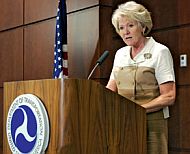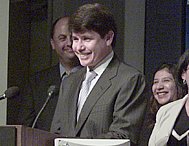Link to article here.
Non Toll Alternative for 281 Proposed
Local officials to submit wish list for federal economic stimulus funds
By Jim Forsyth
WOAI Newsradio
Wednesday, January 14, 2009
For the first time ever, officials are floating a proposal to build the long planned new main lanes of US 281 outside of Loop 1604, without making them toll lanes, 1200 WOAI news reports.
The Regional Mobility Authority today proposed submitting $2.7 billion in local highway construction projects for approval under the proposed Federal Infrastructure Economic Stimulus Act, which President Elect Barack Obama says will allocate hundreds of billions of dollars to ‘shovel worthy’ projects nationwide as a way to create jobs. One of the proposals submitted by the RMA is the $585 million US 281 construction project.
“If those dollars are going to be pushed through to communities across the nation, we’re saying, we have the projects, we’re ready to go, and this will solve real needs in our community today,” said Dr. William Thornton, former San Antonio Mayor and RMA Chairman.
Other projects on the RMA’s wish list include the long awaited interchange between US 281 and Loop 1604, which Thornton says has already obtained environmental clearance and could begin construction immediately, and expansion of Loop 1604 from Military to Braun Road into a six lane expressway. Also, construction of an interchange at Loop 1604 and State Highway 151 near Sea World is on the list, along with completion of the Wurzbach Parkway.
Thornton says any of the projects approved would be designated as ’free’ roadways and tolls would not be collected.
“Tolling is simply a way to pay for the project,” he said. “If the project is paid for through federal funds, you don’t need that option of tolling.”
Thornton held open the possibility that the feds will approve construction of a portion of 281, leaving local officials to find a way to pick up the tab for the rest.
He says competition will be stiff for the money, but he says the San Antonio projects
Have additional advantages that projects in other communities may not have.
>
“These projects are not just for convenience,” he said. “The congestion which exists in that area is not only terribly inconvenient for motorists, but it is also an environmental issue when it comes to clean air due to the idling traffic. None of us like cars driving over the Aquifer, and what we like even less is cars sitting over the Aquifer with their motors running. So this is more than just building a road, it solves congestion, clean air issues, and has many benefits that other projects around the country may not have.”
The economic stimulus plan has not been approved by Congress, so it is unclear when a decision may be mad eon which projects to fund. The RMA’s proposals still have to be approved by the Metropolitan Planning Organization, a move Thornton says he hopes will happen next week.


 The US Department of Transportation (US DOT) has falsely suggested that the nationwide drop in vehicle miles traveled is endangering the revenue source used to maintain America’s highway network. Soaring gasoline prices in the summer and the ongoing recession together forced motorists to cut back substantially on travel, resulting in 100 billion fewer miles being driven in fiscal 2008. Transportation officials seized upon these facts to argue that the gas tax is unsustainable and that the country must quickly shift to tolling to save the highway trust fund.
The US Department of Transportation (US DOT) has falsely suggested that the nationwide drop in vehicle miles traveled is endangering the revenue source used to maintain America’s highway network. Soaring gasoline prices in the summer and the ongoing recession together forced motorists to cut back substantially on travel, resulting in 100 billion fewer miles being driven in fiscal 2008. Transportation officials seized upon these facts to argue that the gas tax is unsustainable and that the country must quickly shift to tolling to save the highway trust fund. The green in Governor Rod R. Blagojevich’s “Green Lane” tolling proposal was headed to the pocket of the Illinois Democrat, according to charges filed this weekend. Most of the attention drawn to yesterday’s arrest of Blagojevich and his chief of staff, John Harris, has centered on the governor’s reported attempt to sell the US Senate seat being vacated by President-elect Barack Obama (D). Blagojevich’s “Tomorrow’s Transportation Today” scheme to impose new tolls on motorists for the enrichment of his personal campaign contributors has received less scrutiny. Blagojevich took office in 2003 after his predecessor, George Ryan (R) was similarly arrested for corruption.
The green in Governor Rod R. Blagojevich’s “Green Lane” tolling proposal was headed to the pocket of the Illinois Democrat, according to charges filed this weekend. Most of the attention drawn to yesterday’s arrest of Blagojevich and his chief of staff, John Harris, has centered on the governor’s reported attempt to sell the US Senate seat being vacated by President-elect Barack Obama (D). Blagojevich’s “Tomorrow’s Transportation Today” scheme to impose new tolls on motorists for the enrichment of his personal campaign contributors has received less scrutiny. Blagojevich took office in 2003 after his predecessor, George Ryan (R) was similarly arrested for corruption.